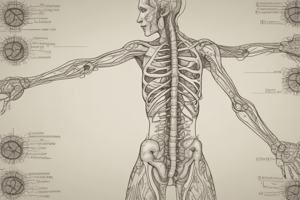Podcast
Questions and Answers
What is the main function of the parasympathetic nervous system?
What is the main function of the parasympathetic nervous system?
- To regulate the nervous system as a whole
- To promote digestion, reproduction, and relaxation (correct)
- To stimulate the 'fight-or-flight' response
- To control voluntary actions
Which system is responsible for responding to stress and preserving life?
Which system is responsible for responding to stress and preserving life?
- Somatic nervous system
- Sympathetic nervous system (correct)
- Central nervous system
- Parasympathetic nervous system
What is the neurotransmitter released by the parasympathetic nervous system?
What is the neurotransmitter released by the parasympathetic nervous system?
- Norepinephrine
- Serotonin
- Acetylcholine (correct)
- Dopamine
What is the effect of the sympathetic nervous system on heart rate?
What is the effect of the sympathetic nervous system on heart rate?
What effect does stimulation of the parasympathetic nervous system have on the pupils?
What effect does stimulation of the parasympathetic nervous system have on the pupils?
What is the effect of sympathomimetics on blood glucose levels?
What is the effect of sympathomimetics on blood glucose levels?
What is the primary mechanism of action of sympatholytic drugs?
What is the primary mechanism of action of sympatholytic drugs?
What is the effect of parasympathomimetics on bowel motility?
What is the effect of parasympathomimetics on bowel motility?
Study Notes
Here is a summary of the text in detailed bullet points:
• The nervous system is made up of two systems: the central nervous system (brain and spinal cord) and the peripheral nervous system (cranial nerves and spinal nerves).
• The peripheral nervous system is divided into the somatic system (voluntary actions) and the autonomic system (involuntary, unconscious actions).
• The autonomic system is further divided into the sympathetic nervous system (fight-or-flight response) and the parasympathetic nervous system (rest and digest).
• The sympathetic nervous system is responsible for responding to stress and preserving life, while the parasympathetic nervous system is responsible for promoting digestion, reproduction, and relaxation.
• The sympathetic nervous system's neurons originate in the thoracic and lumbar areas of the spinal cord, while the parasympathetic nervous system's neurons originate in the brainstem and sacral area.
• The sympathetic nervous system releases norepinephrine as its neurotransmitter, while the parasympathetic nervous system releases acetylcholine.
• The sympathetic nervous system stimulates the "fight-or-flight" response, causing increased heart rate, blood pressure, and respiratory rate, among other effects.
• The parasympathetic nervous system, on the other hand, promotes relaxation, digestion, and reduced heart rate and blood pressure.
• The sympathetic nervous system can be stimulated by medications called sympathomimetics, which mimic the effects of the sympathetic nervous system.
• Examples of sympathomimetics include dopamine, norepinephrine, and epinephrine.
• These medications can be used to treat conditions such as shock, anaphylaxis, and respiratory problems like COPD and asthma.
• Side effects of sympathomimetics include increased heart rate, blood pressure, and blood glucose, as well as nervousness and jitteriness.
• The parasympathetic nervous system can be stimulated by medications called parasympathomimetics or cholinergic drugs.
• An example of a parasympathomimetic is neostigmine, which can be used to treat myasthenia gravis, a condition characterized by muscle weakness and facial drooping.
• Side effects of parasympathomimetics include increased salivation, tear production, and bowel motility, as well as muscle weakness and respiratory depression.
• The balance between the sympathetic and parasympathetic nervous systems is crucial for maintaining overall health and responding to stress and danger.• Stimulation of the parasympathetic nervous system leads to smaller pupils, increased saliva production, and increased mucus production, which can cause coughing.
• In the gastrointestinal tract, parasympathetic stimulation increases motility, leading to diarrhea, stomach pains, and cramping.
• Sympatholytic drugs, also known as anticholinergics, block the parasympathetic nervous system, stopping the release of acetylcholine and leading to sympathetic-like symptoms.
• These drugs are used to treat conditions such as hypertension, anxiety disorders, and tachycardia, by lowering heart rate and blood pressure.
• Examples of sympatholytic drugs include beta blockers, such as propranolol, which can cause side effects like bronchoconstriction and bradycardia.
• Non-selective beta blockers can target receptors in the lungs, causing bronchoconstriction, and are contraindicated in patients with asthma.
• Anticholinergic drugs, which inhibit the parasympathetic nervous system, can dilate the airways, increase heart rate, and dilate the pupils.
• Examples of anticholinergic drugs include ipratropium, used to dilate the airways in asthma patients, and atropine, used to increase heart rate in bradycardia patients and dilate pupils after surgery or in cases of eye inflammation.
Studying That Suits You
Use AI to generate personalized quizzes and flashcards to suit your learning preferences.
Description
Learn about the two main systems of the nervous system, including their functions, neurotransmitters, and effects on the body. Understand the role of sympathomimetics and parasympathomimetics in stimulating these systems.




